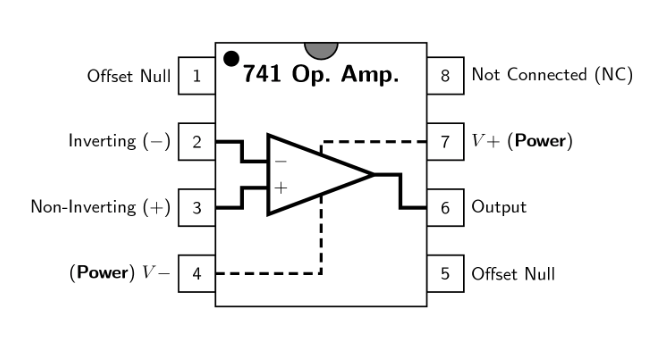
An ideal Op-amp is an ideal
A) Current controlled current source
B) Current controlled Voltage source
C) Voltage controlled Voltage source
D) Voltage controlled current source
Answer
491.4k+ views
1 likes
Hint:The Operational Amplifier has many types of filters (low-pass, high-pass, band-passing, buffer, invert, non-invert, differential, summative and instrumental), oscillator, band-passes, sources (voltage, current), voltage-to-current (current, current-to - voltage) and other non-linear applications.
Step by Step Solution:
An ideal op amplifier is an op amp that has reasonable conditions for it to function as a 100% effective op-amp. An optimum op amp shows the following functions, all of which are detailed below. Ideal op-amps have an infinite voltage gain, infinitely high impedance, zero output impedance, their gain is independent of the input frequency, they have null voltage offset, and their output will swing positive or negative at the same voltage as the power rail and their output fluctuates immediately at the right level.
The perfect op amp has a current of zero input. This is due to infinite resistance of the input. Since the input resistance is infinite, there is an open circuit at the input, which means that a current at all input terminals is zero.
Therefore,

In the above given diagram, it can be seen that there is no current through the input resistance, therefore considering,
In case of an ideal operational amplifier,
Since there is no current through the input resistance, therefore, there will be no voltage drop across the input terminals.
Therefore, an ideal operational amplifier is an ideal voltage controlled voltage source or option C
Note: There are also limitless bandwidths to run an optimal operational amplifier. This means that the operational amplifier works for all frequency ranges.
Step by Step Solution:
An ideal op amplifier is an op amp that has reasonable conditions for it to function as a 100% effective op-amp. An optimum op amp shows the following functions, all of which are detailed below. Ideal op-amps have an infinite voltage gain, infinitely high impedance, zero output impedance, their gain is independent of the input frequency, they have null voltage offset, and their output will swing positive or negative at the same voltage as the power rail and their output fluctuates immediately at the right level.
The perfect op amp has a current of zero input. This is due to infinite resistance of the input. Since the input resistance is infinite, there is an open circuit at the input, which means that a current at all input terminals is zero.
Therefore,

In the above given diagram, it can be seen that there is no current through the input resistance, therefore considering,
In case of an ideal operational amplifier,
Since there is no current through the input resistance, therefore, there will be no voltage drop across the input terminals.
Therefore, an ideal operational amplifier is an ideal voltage controlled voltage source or option C
Note: There are also limitless bandwidths to run an optimal operational amplifier. This means that the operational amplifier works for all frequency ranges.
Latest Vedantu courses for you
Grade 11 Science PCM | CBSE | SCHOOL | English
CBSE (2025-26)
School Full course for CBSE students
₹41,848 per year
Recently Updated Pages
Master Class 9 General Knowledge: Engaging Questions & Answers for Success

Master Class 9 English: Engaging Questions & Answers for Success

Master Class 9 Science: Engaging Questions & Answers for Success

Master Class 9 Social Science: Engaging Questions & Answers for Success

Master Class 9 Maths: Engaging Questions & Answers for Success

Class 9 Question and Answer - Your Ultimate Solutions Guide

Trending doubts
Give 10 examples of unisexual and bisexual flowers

Draw a labelled sketch of the human eye class 12 physics CBSE

Differentiate between homogeneous and heterogeneous class 12 chemistry CBSE

Differentiate between insitu conservation and exsitu class 12 biology CBSE

What are the major means of transport Explain each class 12 social science CBSE

a Tabulate the differences in the characteristics of class 12 chemistry CBSE




